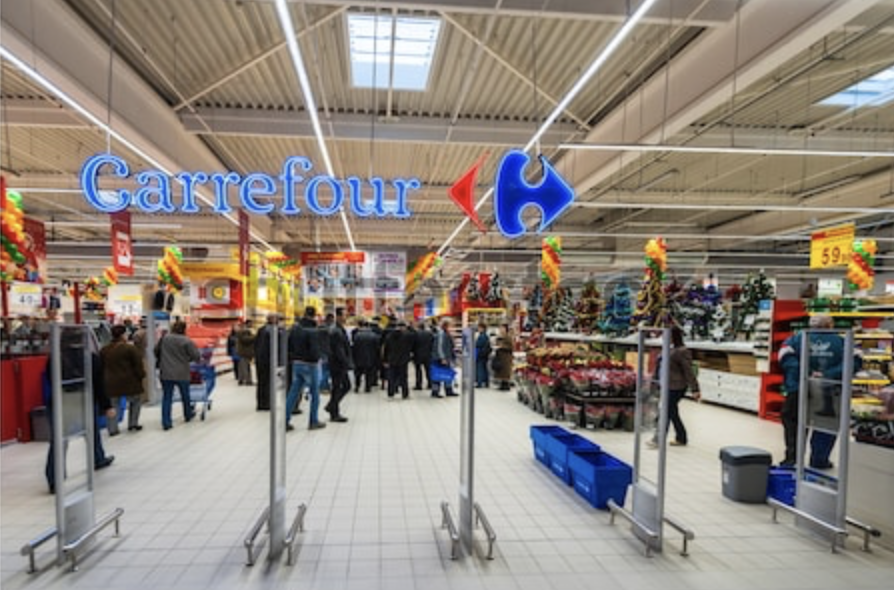Supermarket giant Carrefour is aggressively ramping up its home grocery delivery and click-and-collect options. Ian Kerr (Postal Hub Podcast) and Marek Różycki (Last Mile Experts) analyze the underlying trends driving Carrefour’s new delivery push
French supermarket giant Carrefour is aggressively expanding its home grocery delivery service. By 2020, Carrefour will offer home delivery in all French cities with more than 10,000 inhabitants.
Improving the quality and customer centricity of Carrefour services has been CEO Alexandre Bompard’s goal for some time now. In addition to expanding Carrefour’s delivery capability, the two-hour click and collect service for non-food products will also be made available to a wider market.
To help meet this objective, Carrefour is opening a new fulfilment facility south of Paris, and several points of sale will be able to serve order picking.
The retailer’s goal doesn’t seem unrealistic as its system was tested in 2018 in some 52 outlets, including 23 hypermarkets. In 2018, it is reported that Carrefour’s home delivery service recorded a turnover of €107.3m (US$121m).
The two-hour click and collect service will be expanded to hypermarkets that offer a ‘drive’ service later this year. This should involve some 189 stores, which will show stock availability on the group’s website. Carrefour anticipates significant growth for this super-fast click-and-collect service.
Lessons learned from overseas?
Carrefour recently exited the Chinese market, after two decades of operation. It struggled with growing competition from online grocery retailers. Underlining the importance of delivery in China, Walmart recently announced plans to invest 8 billion yuan (US$1.2bn) in China over the next 10 years to upgrade its logistics.
Last year Carrefour launched its latest Belgian delivery initiative: a personal shopper and delivery service, offering 90-minute delivery for €5 (US5.64) to homes within 4km (2.5 miles) of the store. Carrefour has been very active in trialling new delivery modes in Belgium.
The French consumer
French shopping habits are changing, according to research from Kantar Worldpanel. In November 2018, all physical stores suffered a drop of 0.4%, while online grew its market share by +0.4pt to 6.4%. Spending in click and collect increased by +8.8% in November while spending in hypermarkets simultaneously dropped by -0.6%. People are also visiting a wider number of retailers (7.8 retailers in 2018 compared to 7.1 in 2008)
We can see that delivery is becoming increasingly important in the battle for French consumers’ grocery spend.
Online platforms
Last year Carrefour announced its groceries would be available on Google’s new dedicated shopping site in France, or through Google-operated systems such as connected speakers and voice-assisted devices.
Its rivals have also been active in this space. In 2018 Casino’s upmarket Monoprix chain became the first French retailer to agree to sell products on Amazon, while Casino has a home delivery partnership with Ocado.
Carrefour’s strategy in France
So what does this mean for the French consumer and will this strategy serve Carrefour well? Any move to improve the service offering is clearly a benefit for the consumer, and while we don’t have details of the delivery cost or whether some kind of subscription delivery model will be offered, we support any initiative of this nature. For Carrefour, if the customer-facing terms and conditions are good, we can expect this move to increase sales and improve their competitive position. Success will, however, be dependent also on smart management of the last mile and, in particular, excellent interactive delivery management (such as delivery windows and ‘track your driver’ features). Unattended delivery options, perhaps supported by smart locks, could also be added over time.
Philippe Hemard, founder of logistics consultancy PHC (and, like Różycki, a former VP Amazon Logistics Europe), agrees: “Carrefour seems to have realized that omnichannel supply chain is the only solution to compete with online ecommerce experience. Their success will rely heavily now on perfect execution in inventory management, system integration and last mile operations,” he says.
Overall, the grocery last mile is undergoing a true revolution, with new services and customer centric features springing up everywhere. The question that we still need to understand is whether legacy retailers with large networks, such as Carrefour, can use them to their advantage and compete profitably with ‘aggressors’ such as Amazon.
Ian Kerr will moderate the conference workshops PUDOs & Lockers: the New Power in the Last Mile and Social Media & Communications at Parcel+Post Expo Conference 2019. Marek Różyck will moderate the panel Intelligent Self-Service Solutions and the PUDOs & Lockers: the New Power in the Last Mile workshop.




